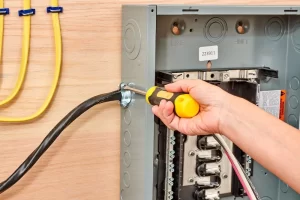The installation of electrical panels is a critical process that directly impacts safety and efficiency. Proper procedures reduce the risk of electrical failures and hazards, such as fires or shocks. Additionally, they enhance energy efficiency and increase the lifespan of components. Understanding the nuances of installation can lead to significant long-term benefits. However, many overlook key aspects that could jeopardize these advantages. What factors should one consider to guarantee a safe and effective installation?
Key Takeaways
- Ensures the electrical panel is compatible with the existing system, preventing overloads and enhancing overall safety.
- Reduces the risk of electrical fires and hazards through proper grounding and bonding techniques.
- Increases energy efficiency, leading to lower utility bills and reduced energy waste.
- Extends the lifespan of the electrical system by facilitating ideal load distribution and minimizing wear and tear.
- Provides peace of mind knowing that installation complies with local codes and is performed by qualified professionals.
Understanding the Importance of Safe Electrical Panel Installation
While many homeowners may underestimate the significance of proper electrical panel installation, it is essential to recognize that safety and functionality are paramount. An electrical panel serves as the hub for a home’s electrical system, regulating power distribution and safeguarding against hazards. Inadequate installation can lead to severe consequences, such as electrical fires, equipment damage, or even injury. Learning the steps for safe electrical panel installation helps foster a sense of responsibility among homeowners, ensuring that they prioritize the well-being of their families and property. Furthermore, a correctly installed panel enhances the efficiency of the electrical system, reducing energy costs and optimizing performance. By valuing safe practices in electrical installations, homeowners contribute to a safer, more connected community, ultimately reinforcing their sense of belonging.
Key Steps for Safe Electrical Panel Installation
Ensuring a safe electrical panel installation requires careful adherence to established protocols and best practices. The initial step involves evaluating the existing electrical system to determine compatibility with the new panel. Subsequently, selecting a suitable location away from moisture and high traffic is vital. Proper grounding and bonding must be established to prevent electrical hazards. During installation, employing appropriate personal protective equipment (PPE) safeguards against potential risks. Additionally, all connections should be tight and secure, ensuring minimal resistance. Following local codes and regulations is essential to maintain compliance and safety standards. Finally, conducting a thorough inspection and testing the system before finalizing the installation solidifies the reliability of the electrical panel. These steps for safe electrical panel installation promote safety and functionality.
Common Mistakes to Avoid in Electrical Panel Installation
Even with a clear understanding of the key steps for safe electrical panel installation, mistakes can still occur during the process. Awareness of common pitfalls can greatly enhance safety and efficiency.
- Inadequate Load Calculation: Failing to properly assess the electrical load can lead to overloading, posing serious risks.
- Neglecting Proper Grounding: Ignoring grounding standards can result in electrical shock hazards and equipment damage.
- Improper Wire Connections: Inaccurate or loose connections can cause arcing, overheating, and potential fire hazards.
The Role of Professional Help in Ensuring Safety
When it comes to safe electrical panel installation, the expertise of a qualified professional can greatly mitigate risks associated with improper handling. Professionals possess the necessary training and experience to navigate complex electrical systems, ensuring compliance with local codes and regulations. Their knowledge allows them to identify potential hazards that may be overlooked by untrained individuals. In addition, they can provide valuable insights during the planning phase, recommending suitable materials and ideal locations for the panel. By engaging a professional, homeowners not only enhance safety but also gain peace of mind. Ultimately, incorporating professional help is a critical step for safe electrical panel installation, fostering a secure environment for all occupants and minimizing future maintenance challenges.

Long-Term Benefits of Proper Electrical Panel Installation
The long-term benefits of proper electrical panel installation extend far beyond initial safety concerns. Ensuring that the installation adheres to the correct steps for safe electrical panel installation can lead to significant advantages for homeowners and businesses alike. These benefits include:
- Increased Reliability: A well-installed electrical panel minimizes the risk of unexpected failures, ensuring a consistent power supply.
- Enhanced Energy Efficiency: Proper installation allows for ideal load distribution, reducing energy waste and lowering utility bills over time.
- Longer Lifespan: Quality installations reduce wear and tear on electrical components, extending the overall lifespan of the electrical system.
Frequently Asked Questions
What Tools Are Necessary for Safe Electrical Panel Installation?
For safe electrical panel installation, essential tools include a voltage tester, screwdriver set, wire cutters, pliers, a multimeter, and a drill. These tools guarantee precision and safety, facilitating a successful and compliant installation process.
How Often Should Electrical Panels Be Inspected?
Electrical panels should be inspected at least every three to five years, or more frequently if signs of wear or malfunction occur. Regular inspections guarantee safety and peak performance, preventing potential hazards and costly repairs.
Can I Install an Electrical Panel Myself?
The suitability of self-installing an electrical panel depends on one’s expertise in electrical systems. Without adequate knowledge, attempting this task may pose safety risks, underscoring the importance of following the right steps for safe electrical panel installation.
What Is the Average Cost of Electrical Panel Installation?
The average cost of electrical panel installation typically ranges from $800 to $2,500, depending on factors such as the panel’s capacity, local labor rates, and any necessary upgrades to the existing electrical system.
Are There Specific Codes for Electrical Panel Installation?
Specific codes for electrical panel installation vary by region, ensuring safety and compliance with local regulations. Adhering to these guidelines is essential for effective installation, minimizing risks and promoting reliability in electrical systems.
Conclusion
To summarize, adhering to the correct procedures for electrical panel installation is paramount for ensuring safety and efficiency in residential electrical systems. By understanding the significance of proper installation, avoiding common pitfalls, and recognizing the value of professional assistance, homeowners can safeguard their properties against potential hazards. Ultimately, investing in a well-executed electrical panel installation not only enhances operational reliability but also promotes energy efficiency and long-term cost savings, underscoring its critical importance in modern electrical management.
You May Also Like To Read:




